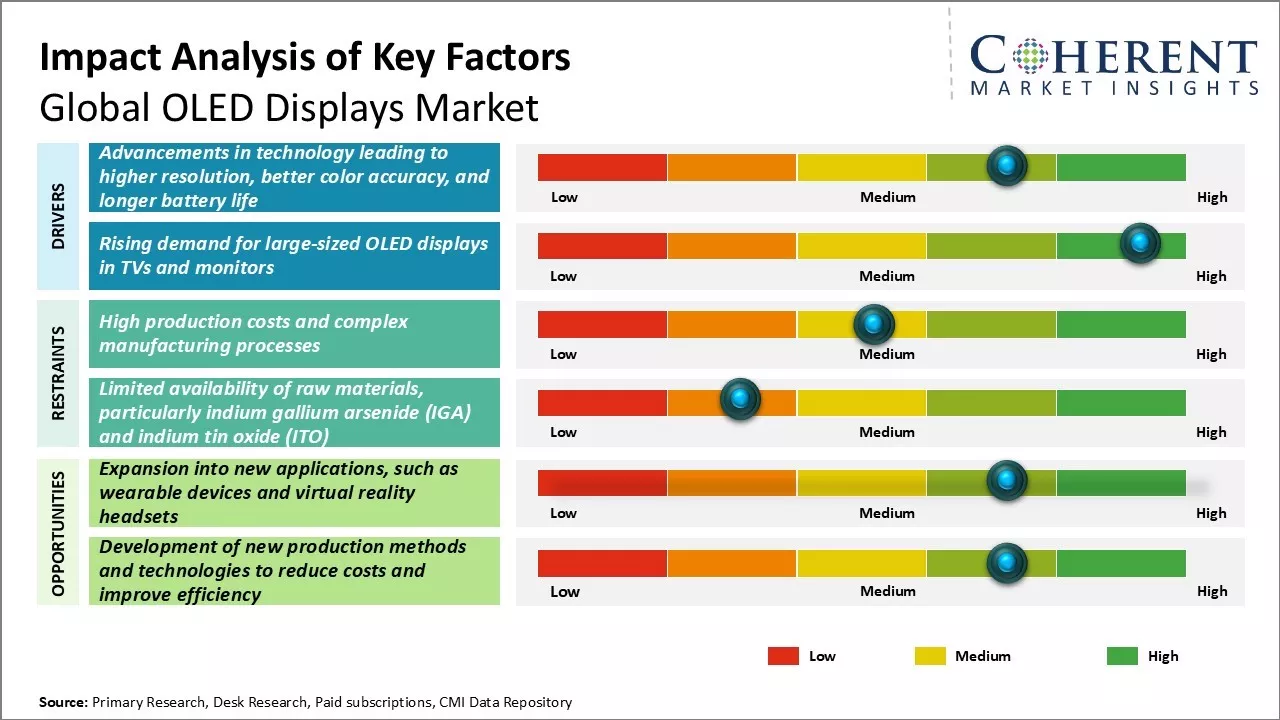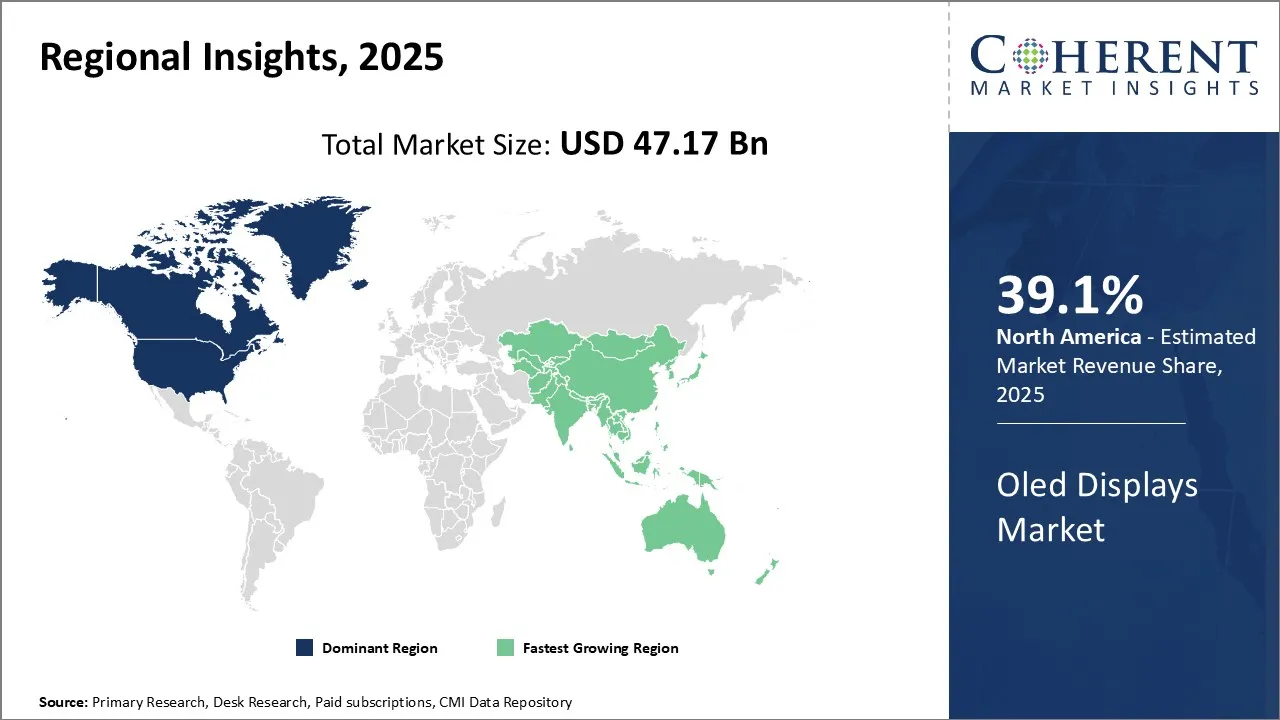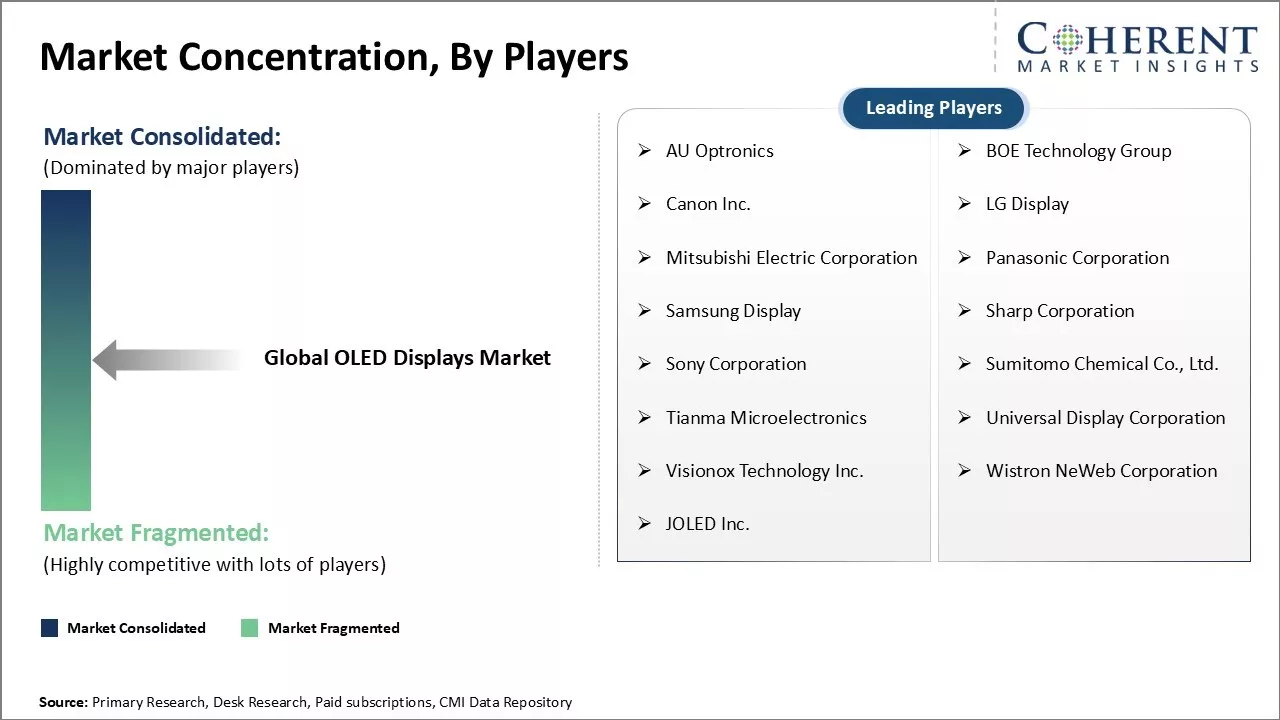The Global OLED Displays Market is estimated to be valued at USD 47.17 Bn in 2025 and is expected to reach USD 121.04 Bn by 2032, exhibiting a compound annual growth rate (CAGR) of 14.4% from 2025 to 2032.

To learn more about this report, Download Free Sample
The OLED Displays Market demand is surging due to growing adoption across smartphones, TVs, wearables, and automotive displays. OLED technology offers superior image quality, energy efficiency, and design flexibility, making it ideal for next-gen consumer electronics. Innovations in foldable and transparent displays are expanding use cases, while declining production costs are boosting accessibility. As digital lifestyles evolve, OLED displays are becoming central to immersive visual experiences across industries.
|
Current Event |
Description and its Impact |
|
Samsung Display's QD-OLED Production Expansion |
|
|
Apple's OLED Adoption Strategy Evolution |
|
Uncover macros and micros vetted on 75+ parameters: Get instant access to report
Artificial Intelligence (AI) is playing a transformative role in the OLED displays market by enhancing design, manufacturing, and user experience. AI-driven algorithms optimize display calibration for richer colors, sharper contrast, and energy efficiency. In production, AI enables predictive maintenance, defect detection, and process automation, improving yield and reducing costs. AI also powers adaptive brightness and content-aware rendering in OLED devices, tailoring visuals to user preferences and ambient conditions. As OLED technology expands into foldable screens, automotive displays, and wearables, AI integration ensures smarter, more responsive interfaces. This synergy between AI and OLED is accelerating innovation and shaping the future of display technology.
For instance, in August 2025, LG Electronics unveiled its 2025 lineup of AI-powered OLED and QNED TVs, promising next-level picture quality and seamless smart features. These advanced displays leverage AI to enhance contrast, color accuracy, and content optimization. With cutting-edge technologies, LG aims to redefine home entertainment and strengthen its leadership in premium TV innovation.
In terms of Display Type, the Flexible OLED Displays segment is estimated to hold 43.0% share of the market in 2025 owing to the rising adoption of bendable and wearable devices. Flexible OLED displays provide several advantages over other types of displays such as high resolution, lighter weight, shatter and impact resistance, and thinness. Major technology companies are actively investing in developing innovative products based on flexible display technology. Smartphones with flexible displays are gaining popularity as they offer convenience of large screen size combined with portability. Similarly, the advent of foldable smartphones and tablets is propelling the demand.
Wearable devices manufacturers prefer flexible OLEDs as they allow developing wearables that conform to body shape and movement. Automotive display screens integrated with features like driver monitoring systems are switching to flexible OLEDs for improved visibility and reliability in varied environmental conditions. Rising demand for innovative form factors from consumer electronics and wearable devices will continue to drive the growth of flexible OLED displays segment.
For instance, in July 2025, Samsung’s Galaxy S25 FE debuted with a flexible OLED display and a sleeker design, according to reports. The new screen technology promises enhanced durability, vibrant visuals, and a thinner profile. This move reinforces Samsung’s push toward advanced display innovation, bringing premium features to its mid-range smartphone lineup.
In terms of Application, the Smartphones and Tablets segment is estimated to hold 45.8% share of the market in 2025 owing to thriving mobile device industry. Adoption of OLED displays is rising rapidly in smartphones and tablets due to their superior display quality, thinness, and power efficiency compared to LCD displays. Leading smartphone brands are aggressively promoting OLED enabled flagship devices to gain competitive edge. At the same time, decline in OLED prices is making it feasible for mid-range smartphones as well. As mobile devices become an integral part of consumers' lives globally, demand for high quality display experience is on the rise which benefits OLED technology. Proliferation of online streaming, gaming, and AR/VR based applications also augment the need for vivid color display and cinematic experience provided by OLEDs. 5G rollout will further fuel innovations in mobile devices and generate additional demand. With high refresh rates and power efficiency, OLED displays are well positioned to support advanced mobile experiences.
For instance, in October 2025, Xiaomi unveiled the world’s first smartphone featuring an S-stripe OLED display with 9.38 million subpixels, setting a new benchmark in mobile screen clarity and color precision. This innovation enhances visual sharpness and positions Xiaomi to compete directly with Apple’s upcoming iPhone 17 series, signaling a leap forward in OLED display technology for smartphones.
In terms of End User, the Consumer Electronics segment is estimated to hold 56.6% share of the market in 2025 owing to the tremendous popularity of OLED TVs. Superior display quality of OLED TVs with perfect blacks, wide viewing angles and vibrant colors is attracting increased consumer interest. Declining prices compared to early generations is expanding the customer base beyond premium segments. Rising disposable incomes in developing regions is propelling lifestyle upgrade among consumers who are willing to pay more for excellence in home entertainment experience. OLED TVs perfectly suit large screen TV viewing experience without compromise on slim design. Content streaming revolution is driving bigger screen sizes at home and creating requirement for sharper, clearer and more immersive viewing experience. Major TV brands introduce new OLED models regularly and invest heavily in marketing to achieve competitive edge over rivals. Favorable word-of-mouth publicity further aids their popularity and demand.
For instance, in May 2025, Samsung Display showcased its latest OLED innovations at COMPUTEX 2025, unveiling ultra-thin UT One OLED panels with 1 Hz refresh rates and high-performance QD-OLED monitors. The exhibit highlighted OLED applications across laptops, tablets, and gaming setups, emphasizing energy efficiency, vivid visuals, and seamless color consistency. These advances reinforce OLED’s growing role in consumer electronics.

To learn more about this report, Download Free Sample
North America is projected to be the dominate the global OLED displays market with an estimated 39.1% share in 2025. The U.S., in particular, is witnessing a surge in demand for OLED televisions from major brands and their widespread adoption among consumers. This has prompted international TV leaders like LG and new entrants like Sony to significantly increase local TV production with OLED technology. Growing smartphone usage and technological preferences have also paved the way for OLED adoption in premium handsets in the region. Additionally, the consumer shift towards large screen smartphones and foldable devices will likely support OLED penetration going forward. Major tech companies intensifying their focus on R&D for novel applications like OLED augmented reality and virtual reality devices signals promising future opportunities as well. Driven by these trends, the North American market is expected to uptick at an accelerated pace compared to other regional markets.
For instance, in October 2025, Panasonic launched its 77-inch Z8BA OLED TV in North America, featuring built-in Fire TV, NVIDIA G-SYNC compatibility, and ATSC 3.0 support. Designed for immersive home entertainment, the OLED panel delivers vibrant visuals and deep contrast. The Z8BA expands Panasonic’s premium cinematic series, catering to tech-savvy consumers and gaming enthusiasts alike.
Asia Pacific is currently the fastest growing region in the global OLED displays market. South Korea is home to leading OLED display manufacturers such as Samsung Display and LG Display, who together account for over 90.5% of the world's OLED panel production. These companies have significantly invested in expanding their production capacity over the past decade to cater to the growing demand. Several other South Korean firms also actively support the OLED supply chain with components and machinery. This strong industry presence starting from R&D to manufacturing has helped South Korea capture a major share of the global market.
For instance, in November 2025, Apple is expected to introduce OLED display technology in its MacBook lineup by 2026. This move signals a shift from LCD to OLED, offering enhanced contrast, thinner form factors, and improved energy efficiency. The displays are likely to be sourced from South Korean manufacturers, with production and assembly involving key partners across Asia.
China’s OLED display market is booming due to rising demand for high-end smartphones, smart TVs, and electric vehicles. Domestic tech giants like Huawei and Xiaomi are driving adoption, while government support and investment in advanced manufacturing, such as inkjet printing OLED plants, boost production capacity. This positions China as a global leader in OLED innovation and consumption.
For instance, in October 2025, TCL China Star Optoelectronics Technology begun building the world’s first 8.6-generation inkjet printing OLED production line in Guangzhou, China. This advanced facility aims to produce large OLED panels for TVs, monitors, and laptops using cost-effective inkjet technology. The move strengthens China’s position in next-gen display manufacturing and challenges South Korea’s industry dominance.
The U.S. OLED display market is driven by strong consumer demand for premium smartphones, smart TVs, laptops, and wearables. Major tech brands like Apple and Samsung fuel adoption, while innovations in automotive and gaming displays expand usage. High disposable income and preference for cutting-edge technology make the U.S. a key market for OLED growth.
For instance, in August 2025, Samsung launched the world’s first 500Hz OLED gaming monitor as part of its new Odyssey G7 lineup. Combining ultra-high refresh rates with OLED’s deep contrast and fast response times, the monitor targets competitive gamers seeking top-tier performance. This innovation reinforces Samsung’s leadership in display technology and sets a new benchmark for gaming visuals.
| Report Coverage | Details | ||
|---|---|---|---|
| Base Year: | 2024 | Market Size in 2025: | USD 47.17 Bn |
| Historical Data for: | 2020 To 2024 | Forecast Period: | 2025 To 2032 |
| Forecast Period 2025 to 2032 CAGR: | 14.4% | 2032 Value Projection: | USD 121.04 Bn |
| Geographies covered: |
|
||
| Segments covered: |
|
||
| Companies covered: |
AU Optronics, BOE Technology Group, Canon Inc., LG Display, Mitsubishi Electric Corporation, Panasonic Corporation, Samsung Display, Sharp Corporation, Sony Corporation, Sumitomo Chemical Co., Ltd., Tianma Microelectronics, Universal Display Corporation, Visionox Technology Inc., Wistron NeWeb Corporation, and JOLED Inc. |
||
| Growth Drivers: |
|
||
| Restraints & Challenges: |
|
||
Uncover macros and micros vetted on 75+ parameters: Get instant access to report
Technological advancements are driving the OLED displays market size upward, due to superior resolution, richer colors, deeper blacks, and thinner profiles compared to LCDs. OLED’s self-emissive pixels enable vivid contrast and energy efficiency. Innovations like inkjet printing and new organic materials boost performance and lifespan. As flexible, rollable, and stretchable OLEDs emerge, adoption across consumer electronics continues to accelerate.

To learn more about this report, Download Free Sample
Advancements in OLED technology are driving consumer demand for larger screen formats, boosting OLED displays market share. Once limited to small devices, OLEDs now dominate big-screen categories like TVs and monitors used for work, learning, and entertainment. Sizes from 55 to 77 inches offer cinema-like experiences with vivid colors and deep blacks.
Rising remote work and online education fuel demand for high-performance 4K and 5K monitors. As prices drop, affordable large OLEDs gain traction across smart TVs, PCs, digital signage, and infotainment. This shift toward bigger screens is a key trend shaping the future of the OLED displays market.
Foldable and rollable devices are set to play a pivotal role in the OLED displays market forecast for 2025. As flexible OLED technology matures, manufacturers are introducing innovative form factors like foldable smartphones, tablets, and rollable TVs that offer portability without compromising screen size or quality. These devices benefit from OLED’s thin, lightweight, and self-emissive properties, enabling sleek designs and vibrant visuals. Consumer interest in multifunctional and space-saving electronics is rising, especially in premium segments. With growing investment in flexible display production and declining costs, foldable and rollable OLEDs are expected to significantly boost market adoption and reshape the future of display technology.
The OLED display market value has entered a decisive maturity phase, moving beyond premium niches to mainstream dominance. OLED panels have overtaken TFT-LCDs in shipments, underscoring a structural shift in the display landscape. Korean firms, notably Samsung and LG, continue to lead through superior IP and yield optimization, LG alone accounts for over 50% of global OLED TV shipments, while Chinese manufacturers aggressively scale flexible OLED production, driving cost reductions and accelerating adoption in smartphones and wearables.
Manufacturing efficiencies have significantly lowered production costs for large OLED panels, reshaping pricing strategies and improving retailer economics. Flexible OLEDs now form a key growth driver, particularly as foldable and curved devices expand beyond flagship segments. However, this rapid scale-up introduces margin pressure in the mid-tier, making technological differentiation, such as QD-OLED, tandem stacks, and advanced driver ICs, critical for maintaining profitability.
OLED’s self-emissive design offers measurable advantages in energy efficiency, contrast, and design flexibility, reinforcing its appeal in automotive, premium TV, and portable devices. The market’s next phase will reward players that combine yield leadership with system-level innovation rather than cost-based competition. In essence, OLED is no longer a transition story, it is the defining standard of next-generation visual interfaces.
Definition: The Global OLED Displays Market involves the manufacturing and sale of organic light-emitting diode display panels across international markets. OLED displays offer superior contrast, color accuracy, and refresh rates compared to traditional LCD displays. They are increasingly being used in high-end consumer electronics like smartphones, televisions, tablets, laptops and other devices.
Share
Share
About Author
Monica Shevgan has 9+ years of experience in market research and business consulting driving client-centric product delivery of the Information and Communication Technology (ICT) team, enhancing client experiences, and shaping business strategy for optimal outcomes. Passionate about client success.
Missing comfort of reading report in your local language? Find your preferred language :
Transform your Strategy with Exclusive Trending Reports :
Frequently Asked Questions
Joining thousands of companies around the world committed to making the Excellent Business Solutions.
View All Our Clients